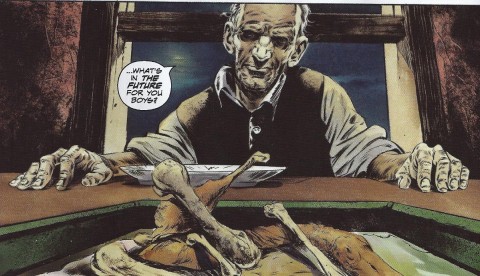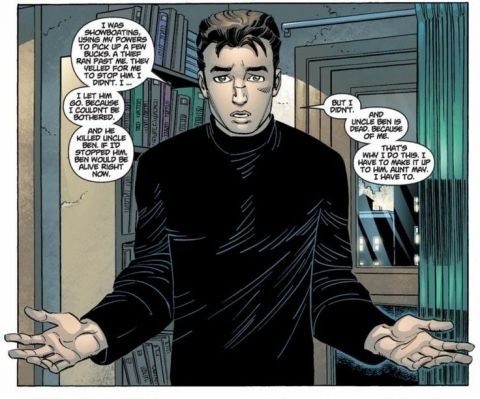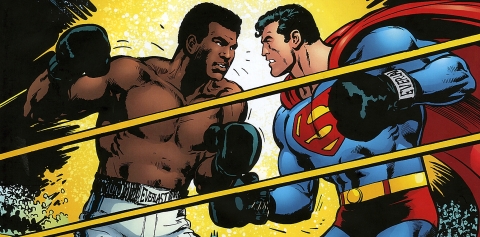52 weeks. 52 different writers. 2 trade paperbacks or hardcovers a week. Each week I’ll take a look at a different writer and read two different collected editions from within that person’s repertoire to help in the examination of their work.
Scott Snyder is predominantly known for relaunching Batman back in 2011 for the New 52 reboot for DC Comics. Shortly before that time, Snyder had a brief stint on Detective Comics with Francesco Francavilla and Jock as his artists. The three men would all receive a large amount of critical and fan praise for their work on the book, garnering them a New York Times Bestseller as well as being deemed one of the best books of 2011 by the website Amazon. Snyder’s time with Batman during his Detective Comics run is widely regarded as one of the primary reasons he was tasked with writing the main Batman title when the New 52 began.
Batman: The Black Mirror
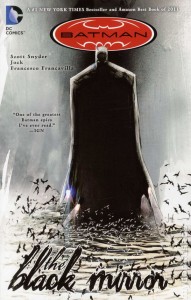 Bruce Wayne, believed to have been deceased, returns to Gotham City and founds Batman Incorporated, a worldwide program that provides Batmen and Batwomen to different countries. During his absence, Dick Grayson, formerly Nightwing, has taken up the mantle of Batman for Gotham City with Bruce remaining uninterested in immediately returning to the role. When items from GCPD’s evidence locker begin to mysteriously disappear and end up in the wrong hands, Batman discovers that a new villain named “The Dealer” has jumped on to the scene, auctioning off these objects. Meanwhile, Jim Gordon’s psychopathic son, James, suddenly returns to Gotham City seeking to make amends with his father, claiming to have found a cure for his dark ways. Jim Gordon struggles with trusting his son while trying to help Batman deal with an increasing string of unusual crimes.
Bruce Wayne, believed to have been deceased, returns to Gotham City and founds Batman Incorporated, a worldwide program that provides Batmen and Batwomen to different countries. During his absence, Dick Grayson, formerly Nightwing, has taken up the mantle of Batman for Gotham City with Bruce remaining uninterested in immediately returning to the role. When items from GCPD’s evidence locker begin to mysteriously disappear and end up in the wrong hands, Batman discovers that a new villain named “The Dealer” has jumped on to the scene, auctioning off these objects. Meanwhile, Jim Gordon’s psychopathic son, James, suddenly returns to Gotham City seeking to make amends with his father, claiming to have found a cure for his dark ways. Jim Gordon struggles with trusting his son while trying to help Batman deal with an increasing string of unusual crimes.
Batman: The Black Mirror may be some of the best work of Scott Snyder’s career. It easily cements him as one of the most talented horror and crime writers in the comic industry today. Working with two exquisite artists, Jock and Francesco Francavilla, Scott Snyder is guaranteed to quicken your pulse and leave your hair standing on edge as you climb through this exhilarating and terrifying thriller/crime story. This collection works in a fantastic way, providing you with the story in a clean and interesting way, being broken down into down different narratives. The first narrative follows Dick Grayson as Batman, dealing with plenty of unusual crimes that highlight the difference of skills between himself and Bruce Wayne as the Caped Crusader. The second set of stories is all about Jim Gordon and his son, James, as the two try to reconcile their differences and distrust to forge a path towards a renewed relationship. Each story arc is only a few issues long before it transitions over to the other narrative. What makes this work so well is the fact that is gives you two wildly different stories that still intersect but don’t need to be read together to work. Flipping between the playful Grayson and the grizzled vet in Gordon is a great bit of writing on Snyder’s part as you get stories that never feel like they’re beating the same drum repeatedly.
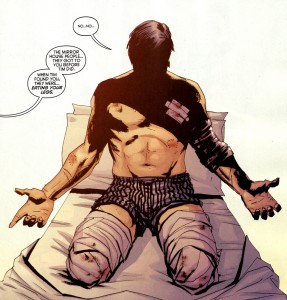
I have to reiterate it again that this is as much a horror story or thriller as it is just a straight up crime story. Off the top of my head I can’t think of many fantastic horror related Batman stories and that might be why this one works as well as it does. Batman, by nature, has dozens of horrific villains but having these types of villains doesn’t not necessarily equate to a horror story. As such, Snyder goes for less twisted villains (although one or two villains like that may pop up in this story) and instead focuses on darker aspects of the human nature. Sanity and greed are two themes deeply explored in both of the narratives Snyder carries throughout the story, with Batman’s side of things dealing with the criminal element of acquisition and control while Gordon deals with the psychosis of criminals. Why this is so brilliant, at least in my opinion, has to be because these themes all create a horror story in a way you wouldn’t expect. It never really sinks in that this is the direction the story is heading until you get to the first chapter that is exclusively about Gordon, which reintroduces his son, James, into the equation and makes him question everything he’s ever thought about in regards to his twisted son. The plotting of these stories and their general themes will have you climbing through this collection of issues with a fevered pace as you simply can’t wait to find out what happens next.
In some ways this collection really reminds me of Frank Miller’s “Batman: Year One” story. The most obvious comparison is the fact that it follows both Jim Gordon and Batman but because of Snyder’s writing style that may be about as far as you can take the comparisons. Snyder absolutely nails it while writing both of the leads here, showing a deep understanding for the emotional Dick Grayson and the tired, uneasy Gordon. Whenever Snyder gets a chance to write a scene about how these characters feel you can’t help but pay attention. Throughout the entire volume he plays up Grayson’s nature in regards to being a different type of Batman than Bruce Wayne, enjoying patrolling Gotham from above and soaring through the air, unlike Bruce who preferred to be down in the streets and see the vile nature of the city first hand. You get a true sense that Grayson actually loves being Batman, doing it as much out of pure enjoyment as he does out of desire to keep Gotham and its citizens safe. This sharply contrasts the character of Bruce Wayne who is largely fueled from the death of his parents to undertake the mission of Batman, choosing to protect the city out of a sense of vengeance. In changing these fundamental parts of Batman’s mission by having Grayson take on the role, you see how it effects his relationship with Jim. Anytime Batman and Gordon appear together in this volume there’s a more laid back dynamic than when Bruce was under the cowl. This is all highlighted by a simple, brilliant and hilarious scene that everyone needs to read in one of the earlier issues. It basically epitomizes the key difference between Bruce Wayne and Dick Grayson.
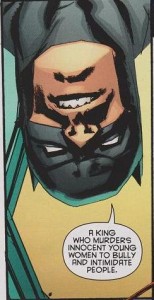 One of the most rewarding parts of this story lies in how Snyder works the primary antagonist into the narrative as well as the character’s personality. As highlighted in the script by Snyder for issue #871, the true villain of this story is the opposite of both Jim Gordon and Dick Grayson. Wherein Dick Grayson is an emotional character who wears his heart on his sleeve, the villain instead is apathetic instead of empathetic like Grayson. When it comes to Jim Gordon, he’s a man who as Snyder states “is all about solving things”, making the villain an unsolvable character, one whom Gordon can’t figure out just at the first glance. On top of all of this, Snyder does a fantastic job of using Gotham as a character as well, playing with the idea of whether or not the city makes people sick and twisted. Are the men and women who turn evil in Gotham born that way or is it because they were born in Gotham specifically? It’s something that Snyder explores with great success but still leaves an air to mystery to it.
One of the most rewarding parts of this story lies in how Snyder works the primary antagonist into the narrative as well as the character’s personality. As highlighted in the script by Snyder for issue #871, the true villain of this story is the opposite of both Jim Gordon and Dick Grayson. Wherein Dick Grayson is an emotional character who wears his heart on his sleeve, the villain instead is apathetic instead of empathetic like Grayson. When it comes to Jim Gordon, he’s a man who as Snyder states “is all about solving things”, making the villain an unsolvable character, one whom Gordon can’t figure out just at the first glance. On top of all of this, Snyder does a fantastic job of using Gotham as a character as well, playing with the idea of whether or not the city makes people sick and twisted. Are the men and women who turn evil in Gotham born that way or is it because they were born in Gotham specifically? It’s something that Snyder explores with great success but still leaves an air to mystery to it.
A good writer can make an enjoyable story. But in my opinion, it takes great writers to weave unspoken and implied history into characters. It also takes a great writer to pave the way for future stories that other writer could explore. Snyder does both of those things with Black Mirror, as he explores the history of James and Jim Gordon while also laying foundations for stories that other comic writers and artists could (and should!) explore in a decade or two from now. Snyder reaches into the past of the Gordons and enhances the characters of James and Jim in unexpected as well as disturbing ways. Snyder simply injects new layers to these characters that you didn’t realize were there before and come around full circle to make for an interesting read. All this is just accentuated by the ambiguous ending that leaves you wondering how much unspoken damage the villain of this tale truly could have caused.
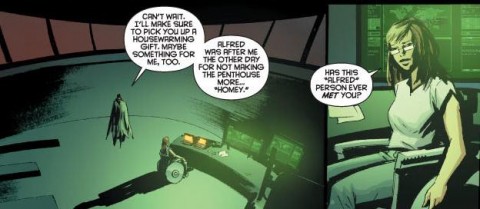
Collects: Detective Comics #871-881.
Best Character: James Gordon.
Best Line Of Dialogue/Caption: “I can’t help it though. I’m built differently. Because there’s something about seeing Gotham from the sky that energizes me, give me hope, if only for a moment…before I come back down to Earth.” – Dick Grayson.
Best Scene/Moment: Jim Gordon trying to adjust to the new Batman. – Issue #872.
Best Issue: Issue #875 – Lost Boys. This issue is a one-and-done story all about Jim Gordon coming to terms with the return of his son, James. Flipping between the past and the present, Jim stalks who he believes to be the “Peter Pan Killer” a man who, fifteen years ago, would kidnap children by sneaking into their bedroom windows at night and then kill them, leaving their bodies to be found out in the streets. While Jim thinks back on the early times of the case, he also thinks back to a trip he took with James, his daughter, Barbara, and his wife, Sarah. This issue tells a fairly dark story that has a killer hook to it because of the storytelling being done across two timelines. This is Snyder at simply his best and the story remains just as strong from this point onward.
Why You Should Read It: This is one of the best Batman stories ever to not feature Bruce Wayne. More importantly it’s one of the best Jim Gordon stories kicking around as well. Thirdly, it’s an incredible horror and crime story. You can pick up this book and get into the rhythm of what’s happening immediately as it’s a gripping tale you can’t put down. This is a wildly different world for Batman than what readers are used to but it’s totally worth the price of admission in what is easily one of the best horror/crime superhero comics to have been produced in the last five, maybe even ten years. Dick Grayson might be a better Batman than Bruce Wayne and it’s stories like Black Mirror that give that argument legs to stand on. This comic is so much more than “just a Batman story” and credit needs to be given to artists like Jock and Francesco Francavilla because without them, the entire mood would have just not worked whatsoever.
Severed
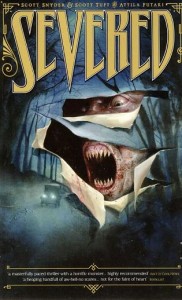 Scott Snyder and Scott Tuft, two longtime friends came together to bring Severed to life. With works like American Vampire, The Wake, or the recently released Wytches, under his belt, Scott Snyder has shown time and time again that he is a writer with serious chops for the horror genre. With the two Scotts teaming together to write this story after years of friendship, they sought to bring to fruition dozens of ideas they’d circled around for their entire lives.
Scott Snyder and Scott Tuft, two longtime friends came together to bring Severed to life. With works like American Vampire, The Wake, or the recently released Wytches, under his belt, Scott Snyder has shown time and time again that he is a writer with serious chops for the horror genre. With the two Scotts teaming together to write this story after years of friendship, they sought to bring to fruition dozens of ideas they’d circled around for their entire lives.
In 1916, Jack Garron lives with his mother, striving to be a talented violin player. One day Jack discovers that his mother has kept an important secret from him which changes his life forever. Jack finds a photograph and a letter that reveals he is actually adopted and his father, J.P. Brakeman, is a talented fiddle player who travels the world. Having discovered the letter, Jack reaches out to his father in secrecy, making contact and learning that he is soon going to be playing a show in Chicago. Looking to surprise his father, Jack train hops his way to Chicago befriending a young drifter named Sam along the way. While the two friends enjoy their open road adventure, a disgusting monster hunts down and devours children across the country, killing them in gruesome fashion.
Scott Snyder is an excellent horror writer. Looking all across his bodies of work, you see that any chance Snyder gets to flex his horror muscles he takes. Co-writing this story with Scott Tuft, Snyder does such brilliantly with Severed, creating a creepy and chilling horror story about traveling and fear of the unknown. It’s the key element to any good horror story, the great unknown element that terrorizes the protagonist and it’s something that Severed just nails down perfectly. What fascinates me even more about this horror series though is how Snyder full on reveals the monster to this story early on, not shying away from acknowledging that this “thing” will be the force of nature that threatens the hero of the story. Even though it’s out there for the reader rather early on, Snyder still leaves so many unknown and unexpected pieces out on the table that you still get the sense of fear even though he almost immediately puts a face to the thing that creates the very fear I speak of. Snyder just gets this innate terror seeded into the narrative that sits and waits for it’s time to strike, lashing out at seemingly all the perfect moments.
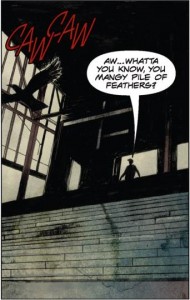 Unlike your big blockbuster horror movie that has an ensemble cast of six or seven twenty-somethings, Snyder and Tuft kept the cast for Severed tight and concise. By my count there’s four, maybe five, major characters throughout the entire story. Jack Garron is a twelve year old boy with a sense of adventure tied to meeting his real father. He’s your curious and foolish young boy who is still infinitely braver than what you’d expect. Snyder and Tuft really get across the apprehensive nature of a young boy out on his own on the unknown road for the first time but still sprinkle in dashes of courage. He’s naive and foolish but still filled with so much hope, which is what constantly pushes him towards trying to find his father. Jack as a character develops so quickly before your eyes that when you get to the final issue and see the actions he takes towards creating a resolution for the story you may be taken aback at first, simply because it all seems like such a quick turnaround for the character to act the way he does. But, when you really take a second to look at Jack’s character throughout the story, you realize that maybe the growth he experiences after only seven issues does make more sense than what you’d first expected.
Unlike your big blockbuster horror movie that has an ensemble cast of six or seven twenty-somethings, Snyder and Tuft kept the cast for Severed tight and concise. By my count there’s four, maybe five, major characters throughout the entire story. Jack Garron is a twelve year old boy with a sense of adventure tied to meeting his real father. He’s your curious and foolish young boy who is still infinitely braver than what you’d expect. Snyder and Tuft really get across the apprehensive nature of a young boy out on his own on the unknown road for the first time but still sprinkle in dashes of courage. He’s naive and foolish but still filled with so much hope, which is what constantly pushes him towards trying to find his father. Jack as a character develops so quickly before your eyes that when you get to the final issue and see the actions he takes towards creating a resolution for the story you may be taken aback at first, simply because it all seems like such a quick turnaround for the character to act the way he does. But, when you really take a second to look at Jack’s character throughout the story, you realize that maybe the growth he experiences after only seven issues does make more sense than what you’d first expected.
The other main characters are Jack’s traveling companion, Sam, the unnamed antagonist, and Jack’s adopted mother, Katharine. Even though Jack is the star of this story, Sam might actually steal the spotlight a bit, as every scene they’re in just seems to shine. Sam is a drifter who becomes Jack’s partner in crime, helping him to survive and make it to find his father. What makes Sam such an invaluable character is his knowledge, as he has the street smarts to make sure he and Jack only get into minimal amounts of trouble. It’s the benefit to having Sam around that really helps Jack during the early parts of the story and serves to make Sam an interesting character to have around.
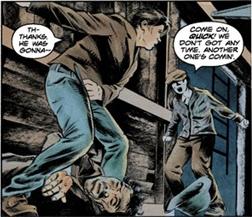 Jack’s mother, Katherine, is and isn’t a main character at the same time. She’s someone who honestly doesn’t play much of a role in the story until a pivotal moment that dictates how the story will end and her character isn’t given much of a chance nor time to develop. The unnamed antagonist is everything you need from a classic horror story. As I said above, it’s the fear of the unknown that makes the horror genre so compelling and that’s what I believe Snyder strives for with this character, to epitomize what the horror genre is really all about. The man can come across as terrifying or menacing but the true reason he only comes across that way is because of how little you actually know about him or what his motivations are. In my mind, the reason this unnamed man works so well as a villain is because Snyder and Tuft leave so much up to the reader for them to inform themselves with. We don’t get an origin story about this man or even an in depth explanation as to why he does what he does.
Jack’s mother, Katherine, is and isn’t a main character at the same time. She’s someone who honestly doesn’t play much of a role in the story until a pivotal moment that dictates how the story will end and her character isn’t given much of a chance nor time to develop. The unnamed antagonist is everything you need from a classic horror story. As I said above, it’s the fear of the unknown that makes the horror genre so compelling and that’s what I believe Snyder strives for with this character, to epitomize what the horror genre is really all about. The man can come across as terrifying or menacing but the true reason he only comes across that way is because of how little you actually know about him or what his motivations are. In my mind, the reason this unnamed man works so well as a villain is because Snyder and Tuft leave so much up to the reader for them to inform themselves with. We don’t get an origin story about this man or even an in depth explanation as to why he does what he does.
Leaving so much up to interpretation can alienate readers who are used to having things explained and expecting the conclusion to be neatly tied together but a writer like Snyder loves lacing subtleties throughout his stories so the reader can piece it together themselves.
Snyder and Tuft choose a great setting for this story, setting it back in 1916, an era without the technological “know how” of our generations. You’re thrust into America during the first World War, with that being a rather minor part of the story for the sake of historical reference. It’s not something that dramatically changes the way the story functions it’s just neat to have Snyder and Tuft set it during this time period and get across the different types of transportation and technology accessible to people. The way characters interact with each other and speak is delivered so convincingly that it’d be impossible for you to argue that this isn’t the way the world was back in 1916. The writing duo also do something excellent with one of the primary characters in regards to the social structure during this time, only further solidifying how great of an idea it was to cast the story during this time frame.
Collects: Severed #1-7.
Best Character: Sam.
Best Line Of Dialogue/Caption: “They say “Home is where the heart is…”, but this place…that I’d spent so many nights dreaming of…the place where I thought I belonged…is all wrong.” – Jack Garron.
Best Scene: Jack and Sam play a tense game with a bear trap – Issue 3: It’s A Jungle Out There.
Best Issue: Issue 3: It’s A Jungle Out There. This was a tough one to choose. I think I ultimately leaned towards this issue because of the tension riddled “Bear Trap” scene late in the issue. There’s plenty of great character moments with Sam’s street smart ways clashing interestingly with Jack’s naivety. This is the issue that flips the story around and sets it on a dark course from which Jack and Sam can never remove themselves from. A solid issue that could’ve been a filler turns out to be a compelling and vital piece to this series.
Why You Should Read It: This is just another example of Scott Snyder’s surprising depth as a writer AND shows that he might be the most underrated horror writer for our generation. When someone says the name “Scott Snyder” we immediately think of Batman because that’s what he’s most well known for but reading his other works like Severed show that Snyder is an amazing horror writer. This is a great miniseries that is a truly chilling horror tale, making you fear the unknown more than some cruel monster. Snyder teams with Scott Tuft to show us how horror in comics should be done. All that, plus there’s a scene in the last issue that I’m absolutely surprised was allowed to be shown in a comic. Be forewarned it’s rather grim but only makes the story that much more interesting.

